taggit
Use of RFID technology to characterize feeder visitations and contact network of hummingbirds in urban habitats.
Ruta R. Bandivadekar, Pranav S. Pandit, Rahel Sollmann, Michael J. Thomas, Scott Logan, Jennifer Brown, A.P. Klimley, and Lisa A. Tell
The notebook demonstrates analysis presented in the manuscript
We developed a Python package ‘taggit’ for reading the tag detection data collapsing it into visits and visualization of PIT tagged hummigbird activity at the novel feeding stations.
## setting up local path and importing python packages
data_path = 'C:/Users/Falco/Desktop/directory/taggit/data/'
path = 'C:/Users/Falco/Desktop/directory/taggit'
output_path = 'C:/Users/Falco/Desktop/directory/taggit/outputs'
## importing python packages
import os as os
import pandas as pd
%matplotlib inline
from bokeh.io import show, output_file , output_notebook, save
output_notebook()
from bokeh.models import Plot, Range1d, MultiLine, Circle, HoverTool, TapTool, BoxSelectTool, BoxZoomTool, ResetTool, PanTool, WheelZoomTool, graphs
from bokeh.palettes import Spectral4
from matplotlib import pyplot as plt
os.chdir(path)
from scipy import stats
import numpy as np
from scipy import stats
import joypy
import seaborn as sns
from matplotlib import pyplot as plt
import numpy as np
from matplotlib import cm
# Importing the taggit package
from taggit import functions as HT
from taggit import interactions as Hxnet
import matplotlib.style as style
style.use('fivethirtyeight')
plt.rcParams['lines.linewidth'] = 1
dpi = 1000
<div class="bk-root">
<a href="https://bokeh.pydata.org" target="_blank" class="bk-logo bk-logo-small bk-logo-notebook"></a>
<span id="3718dfb3-c446-4c06-a65c-7050f53d6e3f">Loading BokehJS ...</span>
</div>
<div class="bk-root">
<a href="https://bokeh.pydata.org" target="_blank" class="bk-logo bk-logo-small bk-logo-notebook"></a>
<span id="e8fc642e-f62e-477d-bc22-8e858e6f3fac">Loading BokehJS ...</span>
</div>
importing data
function: ** read_tag_files**
this function will
1.read all text files from a folder (just keep tag files in this folder no other txt files)
2.remove unwanted tag reads: fishtags, other removes which were some mistakes done during installing readers
3.ability to restrict analysis to to specific location/readers this function will filter the data accordingly
4.for the current analysis presented in the paper we are not inlcuding rufous humminbirds
tag_data = HT.read_tag_files(data_path = data_path, select_readers = ['A1', 'A4', 'A5', 'A8', 'A9', 'B1', 'B2', "B3"],
remove_rufous= True)
Beacuse of battery and power problems A4 reader was not function for some time. We use data from A2 reader which for a top reader from the DAFS for that duration
A2 = HT.read_tag_files(data_path = data_path, select_readers = ['A2'],
remove_rufous= True)
A2 = A2.ix['2018-01-26':'2018-04-30']
A2.Reader.replace('A2', 'A4', inplace= True)
tag_data = pd.concat([tag_data, A2])
C:\Users\Falco\Anaconda2\lib\site-packages\ipykernel_launcher.py:3: DeprecationWarning:
.ix is deprecated. Please use
.loc for label based indexing or
.iloc for positional indexing
See the documentation here:
http://pandas.pydata.org/pandas-docs/stable/indexing.html#ix-indexer-is-deprecated
This is separate from the ipykernel package so we can avoid doing imports until
see first 5 lines in the dataframe
tag_data.head()
| Date | Time | Reader | Tag | ID | DateTime | |
|---|---|---|---|---|---|---|
| DateTime | ||||||
| 2016-09-09 09:55:46 | 2016-09-09 | 10:55:46 | A1 | TAG | 3D6.00184967C6 | 2016-09-09 09:55:46 |
| 2016-09-09 10:23:19 | 2016-09-09 | 11:23:19 | A1 | TAG | 3D6.00184967AE | 2016-09-09 10:23:19 |
| 2016-09-09 10:29:56 | 2016-09-09 | 11:29:56 | A1 | TAG | 3D6.00184967C6 | 2016-09-09 10:29:56 |
| 2016-09-09 10:58:03 | 2016-09-09 | 11:58:03 | A1 | TAG | 3D6.00184967C6 | 2016-09-09 10:58:03 |
| 2016-09-09 11:29:04 | 2016-09-09 | 12:29:04 | A1 | TAG | 3D6.00184967C6 | 2016-09-09 11:29:04 |
print ('number of tag reads during study period= '+str(tag_data.shape[0]))
number of tag reads during study period= 118234
in the manuscript we are analysing data only until March 2018
tag_data = tag_data.ix[:'2018-03-31']
C:\Users\Falco\Anaconda2\lib\site-packages\ipykernel_launcher.py:1: DeprecationWarning:
.ix is deprecated. Please use
.loc for label based indexing or
.iloc for positional indexing
See the documentation here:
http://pandas.pydata.org/pandas-docs/stable/indexing.html#ix-indexer-is-deprecated
"""Entry point for launching an IPython kernel.
list of bird ids visiting the feeder
tag_data.ID.unique()
array(['3D6.00184967C6', '3D6.00184967AE', '3D6.00184967B9',
'3D6.00184967D6', '3D6.00184967D3', '3D6.00184967D7',
'3D6.00184967B5', '3D6.00184967A3', '3D6.00184967A1',
'3D6.00184967C3', '3D6.00184967A9', '3D6.00184967B0',
'3D6.00184967AB', '3D6.00184967DB', '3D6.00184967C4',
'3D6.00184967A8', '3D6.00184967D0', '3D6.00184967F4',
'3D6.00184967BE', '3D6.00184967B6', '3D6.00184967D2',
'3D6.00184967A4', '3D6.00184967EF', '3D6.00184967CB',
'3D6.00184967F5', '3D6.0018496801', '3D6.00184967DA',
'3D6.00184967CC', '3D6.00184967C5', '3D6.00184967E4',
'3D6.00184967FE', '3D6.00184967E1', '3D6.00184967DD',
'3D6.00184967D9', '3D6.0018496802', '3D6.00184967E2',
'3D6.1D593D7826', '3D6.1D593D785E', '3D6.1D593D783E',
'3D6.1D593D7828', '3D6.1D593D7858', '3D6.1D593D7868',
'3D6.1D593D7877', '3D6.1D593D783F', '3D6.1D593D7831',
'3D6.1D593D7872', '3D6.1D593D786F', '3D6.1D593D7853',
'3D6.1D593D782C', '3D6.1D593D787D', '3D6.00184967AD',
'3D6.00184967AF', '3D6.00184967A7', '3D6.00184967BC',
'3D6.00184967E6', '3D6.00184967E7', '3D6.00184967BA',
'3D6.00184967A2', '3D6.00184967A6', '3D6.00184967F1',
'3D6.00184967BF', '3D6.00184967E0', '3D6.00184967B8',
'3D6.00184967ED', '3D6.00184967D1', '3D6.00184967F7',
'3D6.00184967B7', '3D6.00184967D5', '3D6.00184967AC',
'3D6.00184967C8', '3D6.00184967E3', '3D6.1D593D7848',
'3D6.00184967C1', '3D6.1D593D782B', '3D6.00184967F8',
'3D6.1D593D787F', '3D6.00184967E9', '3D6.00184967D4',
'3D6.00184967CE', '3D6.1D593D45E9', '3D6.001881F761',
'3D6.1D593D45D7', '3D6.1D593D45FA', '3D6.1D593D45CB',
'3D6.001881F743', '3D6.1D593D45FF', '3D6.001881F780',
'3D6.001881F777', '3D6.1D593D45D0', '3D6.1D593D460B',
'3D6.1D593D45DA', '3D6.001881F776', '3D6.1D593D45F7',
'3D6.001881F736', '3D6.1D593D45B6', '3D6.1D593D4611',
'3D6.001881F733', '3D6.1D593D45F1', '3D6.001881F782',
'3D6.1D593D4603', '3D6.1D593D45C9', '3D6.1D593D45F2',
'3D6.1D593D7827', '3D6.1D593D7840', '3D6.1D593D45CF',
'3D6.1D593D7843', '3D6.1D593D4612', '3D6.1D593D45D4',
'3D6.1D593D45E4', '3D6.1D593D4609', '3D6.001881F758',
'3D6.001881F76C', '3D6.001881F783', '3D6.001881F784',
'3D6.1D593D7835', '3D6.1D593D45F9', '3D6.1D593D45EB',
'3D6.1D593D45E6', '3D6.1D593D4614', '3D6.1D593D7839',
'3D6.1D593D45EF', '3D6.001881F78A', '3D6.1D593D45E5',
'3D6.1D593D45DF', '3D6.1D593D4604', '3D6.1D593D4607',
'3D6.1D593D45B3', '3D6.1D593D45E1', '3D6.1D593D4606',
'3D6.1D593D460E', '3D6.1D593D45DB', '3D6.1D593D4610',
'3D6.1D593D45D1', '3D6.1D593D45D3', '3D6.1D593D4601',
'3D6.001881F730', '3D6.1D593D460F', '3D6.001881F73A',
'3D6.001881F788', '3D6.1D593D45FB', '3D6.1D593D460A',
'3D6.001881F775', '3D6.1D593D45CE', '3D6.1D593D45C7',
'3D6.1D593D7838', '3D6.1D593D7880', '3D6.1D593D460D',
'3D6.1D593D45F3', '3D6.1D593D7845', '3D6.1D593D45E7',
'3D6.1D593D787A', '3D6.1D593D45E2', '3D6.1D593D45D2',
'3D6.1D593D786B', '3D6.1D593D45B9'], dtype=object)
len(tag_data.ID.unique())
155
even though we have 155 birds detected in the data, we restrict our analysis to birds that have been tagged until end February 2018
collapse_reads_10_seconds
this function will
1. for each individual bird, it will calculate different between each reads
2. if the difference is more that 0.11 seconds it will identify it as a new visit.
3. for each new visit, it will identify the starting time, ending time
visit_data = HT.collapse_reads_10_seconds(data= tag_data)
visit_data.head()
| visit_start | visit_end | ID | Tag | visit_duration | |
|---|---|---|---|---|---|
| 0 | 2016-09-25 05:53:00 | 2016-09-25 05:53:00 | 3D6.00184967A1 | A1 | 0 days |
| 1 | 2016-10-26 13:32:31 | 2016-10-26 13:32:31 | 3D6.00184967A1 | A1 | 0 days |
| 2 | 2016-10-26 13:33:34 | 2016-10-26 13:33:34 | 3D6.00184967A1 | A1 | 0 days |
| 3 | 2016-10-26 14:38:35 | 2016-10-26 14:38:35 | 3D6.00184967A1 | A1 | 0 days |
| 4 | 2016-10-26 15:10:45 | 2016-10-26 15:10:45 | 3D6.00184967A1 | A1 | 0 days |
#visit_data.to_csv(output_path +'\Collapsed_visits.csv')
#visit_data.to_csv(team_path +'\Collapsed_visits.csv')
number of visits recorded
print ('number of visits recorded during study period= '+str(visit_data.shape[0]))
number of visits recorded during study period= 65476
read metadata file
this function will
1. read the master metadata file for all the birds PIT tagged until now
2. filter the data according to the study location
meta = HT.read_metadata(data_path = data_path , filename = 'PIT tagged Birds Info_HHCP_For manuscript_04_16_2018.xlsx',
restrict = True)
meta = meta.drop_duplicates('Tag Hex', keep= 'first')
meta['Location Id'].unique()
## removing data for birds tagged in another site not in this study
remove_glide = list(set(meta[meta['Location Id'] == 'GR']['Tag Hex'].unique().tolist()).difference(set(visit_data.ID.unique().tolist())))
meta = meta[~meta['Tag Hex'].isin(remove_glide)]
meta.Species.unique()
meta.shape
(230, 12)
meta.Species.unique()
array([u'ANHU', u'ALHU'], dtype=object)
meta.head()
| SrNo. | Tagged Date | Location Id | Tag Hex | Tag Dec | Species | Age | Sex | Band Number | Location | Notes | True Unknowns | |
|---|---|---|---|---|---|---|---|---|---|---|---|---|
| 0 | 1 | 2016-09-02 | SB | 3D6.00184967FF | 982.000407 | ANHU | HY | F | NaN | Manfreds | NaN | NaN |
| 1 | 2 | 2016-09-02 | SB | 3D6.00184967FC | 982.000407 | ANHU | HY | F | NaN | Manfreds | NaN | NaN |
| 2 | 3 | 2016-09-02 | SB | 3D6.00184967B0 | 982.000407 | ANHU | AHY | M | NaN | Manfreds | NaN | NaN |
| 3 | 4 | 2016-09-02 | SB | 3D6.00184967F3 | 982.000407 | ANHU | HY | M | NaN | Manfreds | NaN | NaN |
| 4 | 5 | 2016-09-02 | SB | 3D6.00184967DF | 982.000407 | ANHU | AHY | F | NaN | Manfreds | NaN | NaN |
merge TAG data and Metadata
this function will 1. merge the tag read data with the metadata using the ‘Tag Hex’ column 2. Merge the data only after running collapse_reads_10_seconds function 3. identifies birds which were tagged and found on the same day in 2016
data = HT.merge_metadata(data = visit_data, metadata = meta, for_paper = False)
3D6.00184967A3 date same, first recorded 2016-09-23 08:56:09 tagged on 2016-09-23
3D6.00184967AE date same, first recorded 2016-09-09 10:23:19 tagged on 2016-09-09
3D6.00184967B5 date same, first recorded 2016-09-23 08:54:49 tagged on 2016-09-23
3D6.00184967C6 date same, first recorded 2016-09-09 09:55:46 tagged on 2016-09-09
3D6.00184967D3 date same, first recorded 2016-09-23 08:52:58 tagged on 2016-09-23
3D6.00184967D6 date same, first recorded 2016-09-23 08:05:57 tagged on 2016-09-23
3D6.00184967D7 date same, first recorded 2016-09-23 08:54:00 tagged on 2016-09-23
3D6.00184967DB date same, first recorded 2016-10-21 08:20:40 tagged on 2016-10-21
even though we have 155 birds detected in the data, we restrict our analysis to birds that have been tagged until end February 2018
a = meta['Tag Hex'].unique().tolist()
data = data[data['ID'].isin(a)]
meta.Location.unique()
array([u'Manfreds', u'Arboretum', u'Glide Ranch', u"Susan's"],
dtype=object)
data['Location'].value_counts()
Arboretum 25210
Susan's 18478
Manfreds 14609
Glide Ranch 753
Name: Location, dtype: int64
data.Species.unique()
array([u'ANHU', u'ALHU'], dtype=object)
data.Species.value_counts(normalize=True)
ANHU 0.908535
ALHU 0.091465
Name: Species, dtype: float64
Bird_summary, reader_predilection = HT.bird_summaries(data = data,
output_path = output_path,
metadata = meta)
Bird_summary[['obser_period', 'first_obs_aft_tag', 'date_u']].describe()
| obser_period | first_obs_aft_tag | date_u | |
|---|---|---|---|
| count | 141 | 141 | 141.000000 |
| mean | 88 days 19:44:40.851063 | 31 days 10:33:11.489361 | 24.581560 |
| std | 110 days 01:02:39.808943 | 58 days 15:34:02.081666 | 44.338174 |
| min | 0 days 00:00:00 | 0 days 00:00:00 | 1.000000 |
| 25% | 16 days 00:00:00 | 0 days 00:00:00 | 2.000000 |
| 50% | 34 days 00:00:00 | 5 days 00:00:00 | 4.000000 |
| 75% | 122 days 00:00:00 | 32 days 00:00:00 | 28.000000 |
| max | 554 days 00:00:00 | 444 days 00:00:00 | 289.000000 |
Table 1
pd.pivot_table(meta, index = 'Species', columns=['Sex', 'Age'], values='Tag Hex', aggfunc='count', margins= True, fill_value=0)
| Sex | F | M | All | ||||
|---|---|---|---|---|---|---|---|
| Age | AHY | HY | UNK | AHY | HY | UNK | |
| Species | |||||||
| ALHU | 6 | 0 | 8 | 26 | 2 | 21 | 63 |
| ANHU | 27 | 23 | 18 | 39 | 40 | 20 | 167 |
| All | 33 | 23 | 26 | 65 | 42 | 41 | 230 |
pd.pivot_table(meta, index = 'Species', columns='Age', values='Tag Hex', aggfunc='count', margins= True, fill_value=0)
| Age | AHY | HY | UNK | All |
|---|---|---|---|---|
| Species | ||||
| ALHU | 32 | 2 | 29 | 63 |
| ANHU | 66 | 63 | 38 | 167 |
| All | 98 | 65 | 67 | 230 |
table1 = HT.report_Table1A(metadata = meta, location= ['SB', 'Arbo -1 ','BH', 'GR'])
table1.to_csv(output_path+'/table1.csv')
table1
| Species | Allen's Hummingbird | Anna's Hummingbird | All |
|---|---|---|---|
| Sex | |||
| female | 14 | 68 | 82 |
| male | 49 | 99 | 148 |
| All | 63 | 167 | 230 |
Table 2
table2 = HT.report_Table2Paper(metadata = meta, location= ['SB', 'Arbo -1 ','BH', 'GR'] )
table2.to_csv(output_path+'/table2.csv')
table2
| Species | Allen's Hummingbird | Anna's Hummingbird | All |
|---|---|---|---|
| Location Id | |||
| Arbo -1 | 0 | 36 | 36 |
| BH | 63 | 78 | 141 |
| GR | 0 | 3 | 3 |
| SB | 0 | 50 | 50 |
| All | 63 | 167 | 230 |
Table 4
table4 = HT.paper_Table2(data = data, metadata = meta, location= ['SB', 'Arbo -1 ','BH', 'GR'])
table4.to_csv(output_path+'/table4.csv')
table4
| Sex | female | male | All | ||||
|---|---|---|---|---|---|---|---|
| Age | after hatch year | hatch year | unknown | after hatch year | hatch year | unknown | |
| Species | |||||||
| Allen's Hummingbird | 3 | 0 | 6 | 12 | 1 | 12 | 34 |
| Anna's Hummingbird | 18 | 17 | 6 | 28 | 25 | 13 | 107 |
| All | 21 | 17 | 12 | 40 | 26 | 25 | 141 |
pd.pivot_table(data, columns='Sex', index='Species', aggfunc='nunique', values='ID')
| Sex | F | M |
|---|---|---|
| Species | ||
| ALHU | 9 | 25 |
| ANHU | 41 | 66 |
pd.pivot_table(data, columns='Age', index='Species', aggfunc='nunique', values='ID')
| Age | AHY | HY | UNK |
|---|---|---|---|
| Species | |||
| ALHU | 15 | 1 | 18 |
| ANHU | 46 | 42 | 19 |
Figure 5:
Daily visitations of PIT- tagged male and female Anna’s Hummingbirds at the feeding stations at Sites 1 and 2 in Northern California and Site 3 in Southern California from September 2016 to March 2018.
import matplotlib.ticker as ticker
import matplotlib.dates as mdates
data.Sex.fillna('unknown', inplace= True)
alhu_data = data[data.Species == "ALHU"]
anhu_data = data[data.Species == "ANHU"]
plt.rcParams['font.size'] = 13
plt.rcParams['font.family'] = 'Times New Roman'
plt.rcParams['axes.labelsize'] = plt.rcParams['font.size']
plt.rcParams['axes.titlesize'] = 1.5*plt.rcParams['font.size']
plt.rcParams['legend.fontsize'] = plt.rcParams['font.size']+1
plt.rcParams['xtick.labelsize'] = plt.rcParams['font.size']
plt.rcParams['ytick.labelsize'] = plt.rcParams['font.size']
def plotvisits(timeunit, data, ax, c = ['#e41a1c', '#377eb8', '#4daf4a'], style = '-'):
"""timeunite: 10Min, D = day, W = week, M = month"""
if timeunit == '10Min':
t = '10 minutes'
elif timeunit == 'D':
t = 'day'
elif timeunit == 'W':
t = 'week'
if timeunit == 'M':
t = 'month'
a = data.groupby([ pd.Grouper(freq=timeunit), 'Sex'])['ID'].count().unstack('Sex')
a.plot(kind="line", style = style, rot =45, ax= ax,stacked=False, color = c,)
#set ticks every month
ax.xaxis.set_major_locator(mdates.MonthLocator())
#set major ticks format
ax.xaxis.set_major_formatter(mdates.DateFormatter('%b %Y'))
## hiding every second month
for index, label in enumerate(ax.xaxis.get_ticklabels()):
if index % 3 != 0:
label.set_visible(False)
#ax.set_title('visits per '+t)
ax.set_xlabel('Time')
ax.set_ylabel('Number of visits per day')
f, (ax1) = plt.subplots(1, 1, figsize=(8,6))
plotvisits(timeunit= 'D', data = anhu_data, ax= ax1)
f.tight_layout(rect=[0, 0.03, 1, 0.95])
plt.savefig(output_path + '\Figure4.png', dpi = dpi)
plt.savefig(output_path + '\Figure4.eps',format = 'eps', dpi = dpi)
plt.show()

[item.get_text() for item in ax1.get_xticklabels()]
[u'Sep 2016',
u'Oct 2016',
u'Nov 2016',
u'Dec 2016',
u'Jan 2017',
u'Feb 2017',
u'Mar 2017',
u'Apr 2017',
u'May 2017',
u'Jun 2017',
u'Jul 2017',
u'Aug 2017',
u'Sep 2017',
u'Oct 2017',
u'Nov 2017',
u'Dec 2017',
u'Jan 2018',
u'Feb 2018',
u'Mar 2018',
u'Apr 2018']
anhu_data.index
DatetimeIndex(['2016-09-25 05:53:00', '2016-10-26 13:32:31',
'2016-10-26 13:33:34', '2016-10-26 14:38:35',
'2016-10-26 15:10:45', '2016-10-26 15:46:14',
'2016-10-26 16:12:54', '2016-10-27 10:38:53',
'2016-10-28 09:12:40', '2016-10-29 10:53:49',
...
'2018-03-06 07:31:05', '2018-03-06 07:31:20',
'2018-03-06 10:35:45', '2018-03-06 10:36:07',
'2018-02-27 16:45:14', '2018-03-06 16:03:50',
'2018-02-28 13:10:57', '2018-02-28 13:12:39',
'2018-02-28 13:13:00', '2018-02-28 13:13:14'],
dtype='datetime64[ns]', name=u'visit_start', length=53649, freq=None)
data.shape
(59050, 19)
Tagging activity Figure 5 Inset: The cumulative tagging effort throughout the study.
import matplotlib.dates as mdates
fig, ax1 = plt.subplots(1, figsize=(6,4))
idx = pd.date_range('06.01.2016', '02.28.2018')
a = meta.groupby('Tagged Date')['Tag Hex'].nunique()
a.index = pd.DatetimeIndex(a.index)
a = a.reindex(idx, fill_value=0)
#tl = a.cumsum()
#tl.columns = ['sampling']
#tl.plot.line(drawstyle = 'steps', label='Animals', rot =45,ax = ax1)
a.resample('D').cumsum().plot(kind="line", rot =45,ax = ax1)
#set ticks every month
#ax1.xaxis.set_major_locator(mdates.MonthLocator())
#set major ticks format
#ax1.xaxis.set_major_formatter(mdates.DateFormatter('%Y'))
## hiding every second month
#for index, label in enumerate(ax1.xaxis.get_ticklabels()):
# if index % 3 != 0:
# label.set_visible(False)
ax1.set_ylabel('Individuals tagged', fontsize = 11)
ax1.set_xlabel('Time', fontsize = 11)
fig.tight_layout(rect=[0, 0.03, 1, 0.95])
plt.savefig(output_path+'/'+'cumulative_tagging.png', dpi = dpi)
plt.savefig(output_path+'/'+'cumulative_tagging.eps',format = 'eps', dpi = dpi)
plt.show()
C:\Users\Falco\Anaconda2\lib\site-packages\ipykernel_launcher.py:10: FutureWarning:
.resample() is now a deferred operation
You called cumsum(...) on this deferred object which materialized it into a series
by implicitly taking the mean. Use .resample(...).mean() instead
# Remove the CWD from sys.path while we load stuff.
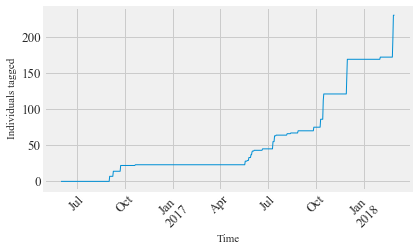
Figure 6:
Comparison of the daily detections from the two different antennas at the double antenna feeding station transceiver at Site 2 over time. The top antenna for this feeding station was deployed in May 2017 and discontinued in January 2018 for data collection. Overall, the total number of visits detected by the side antenna exceeded the number of visits for the top antenna but not enough to warrant the addition of a second antenna. Both antennas detected the presence of the same number of individual birds.
## Top reader
tag_dataA2 = HT.read_tag_files(data_path = data_path, select_readers = ['A2'], )
visit_dataA2 = HT.collapse_reads_10_seconds(data= tag_dataA2)
dataA2 = HT.merge_metadata(data = visit_dataA2, metadata = meta, for_paper = True)
## Side reader
tag_dataA4 = HT.read_tag_files(data_path = data_path, select_readers = ['A4'])
visit_dataA4 = HT.collapse_reads_10_seconds(data= tag_dataA4)
dataA4 = HT.merge_metadata(data = visit_dataA4, metadata = meta, for_paper = True)
dataA4 = dataA4.ix['2017-05-23':'2018-01-25']
dataA2 = dataA2.ix['2017-05-23':'2018-01-25']
C:\Users\Falco\Anaconda2\lib\site-packages\ipykernel_launcher.py:11: DeprecationWarning:
.ix is deprecated. Please use
.loc for label based indexing or
.iloc for positional indexing
See the documentation here:
http://pandas.pydata.org/pandas-docs/stable/indexing.html#ix-indexer-is-deprecated
# This is added back by InteractiveShellApp.init_path()
C:\Users\Falco\Anaconda2\lib\site-packages\ipykernel_launcher.py:12: DeprecationWarning:
.ix is deprecated. Please use
.loc for label based indexing or
.iloc for positional indexing
See the documentation here:
http://pandas.pydata.org/pandas-docs/stable/indexing.html#ix-indexer-is-deprecated
if sys.path[0] == '':
print ('side antenna recorded ' +str(dataA4.shape[0]) + ' visits')
side antenna recorded 7825 visits
print ('top antenna recorded ' +str(dataA2.shape[0]) + ' visits')
top antenna recorded 7620 visits
print ('side antenna recorded ' +str(len(dataA4.ID.unique())) + ' PIT tagged birds')
side antenna recorded 20 PIT tagged birds
print ('top antenna recorded ' +str(len(dataA2.ID.unique())) + ' PIT tagged birds')
top antenna recorded 20 PIT tagged birds
Figure 6
dpi = 1000
def plotvisits(timeunit, data, ax, c = ['#e41a1c', '#377eb8', '#4daf4a']):
"""timeunite: 10Min, D = day, W = week, M = month"""
if timeunit == '10Min':
t = '10 minutes'
elif timeunit == 'D':
t = 'day'
elif timeunit == 'W':
t = 'week'
if timeunit == 'M':
t = 'month'
data.groupby([ pd.Grouper(freq=timeunit)])['ID'].count().plot(kind="line", rot =45, ax= ax)
#set ticks every month
#ax.xaxis.set_major_locator(mdates.MonthLocator())
#set major ticks format
#ax.xaxis.set_major_formatter(mdates.DateFormatter('%Y %B'))
## hiding every second month
#for index, label in enumerate(ax.xaxis.get_ticklabels()):
# if index % 3 != 0:
# label.set_visible(False)
#ax.set_title('visits per '+t)
ax.set_xlabel('Time')
ax.set_ylabel('Number of visits per day')
f, (ax1) = plt.subplots(1, 1, figsize=(8,6))
plotvisits(timeunit= 'D', data= dataA4, ax= ax1)
plotvisits(timeunit= 'D', data= dataA2, ax= ax1)
labels = ['Jun 2017', 'Jul 2017', 'Aug 2017','Sep 2017', 'Oct 2017', 'Nov 2017', 'Dec 2017', 'Jan 2018', 'Feb 2018']
ax1.set_xticklabels(labels)
#set ticks every month
#ax1.xaxis.set_major_locator(mdates.MonthLocator())
#set major ticks format
#ax1.xaxis.set_major_formatter(mdates.DateFormatter('%Y %B'))
## hiding every second month
#for index, label in enumerate(ax1.xaxis.get_ticklabels()):
# if index % 3 != 0:
# label.set_visible(False)
f.legend(['side antenna reader unit', 'top antenna reader unit'],loc = 'best')
#f.suptitle('Hummingbird visits to feeders', fontsize = 24)
f.tight_layout()#rect=[0, 0.03, 1, 0.95]
f.savefig(output_path+'/Figure 5.png', dpi = dpi)
f.savefig(output_path+'/'+'Figure 5.eps',format = 'eps', dpi = dpi)
plt.show()
C:\Users\Falco\Anaconda2\lib\site-packages\matplotlib\legend.py:649: UserWarning: Automatic legend placement (loc="best") not implemented for figure legend. Falling back on "upper right".
warnings.warn('Automatic legend placement (loc="best") not '
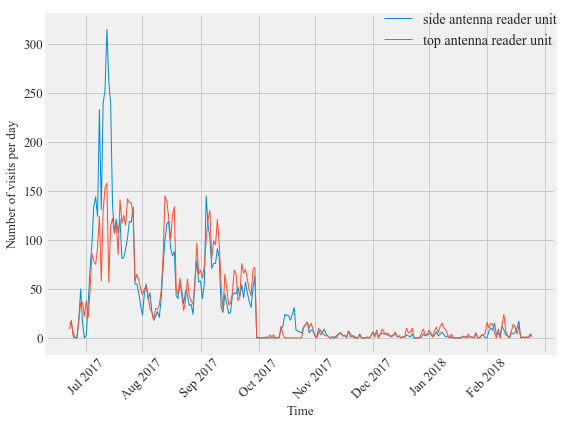
Gender association with activity of bird visitation metrices
v = pd.merge(visit_data, meta, left_on='ID', right_on='Tag Hex', how='left')
sns.violinplot(v.Sex,np.log((v.visit_duration / np.timedelta64(1, 's')).astype(int)+0.0001))
plt.ylabel('visit duration (log)')
plt.show()
C:\Users\Falco\Anaconda2\lib\site-packages\scipy\stats\stats.py:1706: FutureWarning: Using a non-tuple sequence for multidimensional indexing is deprecated; use `arr[tuple(seq)]` instead of `arr[seq]`. In the future this will be interpreted as an array index, `arr[np.array(seq)]`, which will result either in an error or a different result.
return np.add.reduce(sorted[indexer] * weights, axis=axis) / sumval
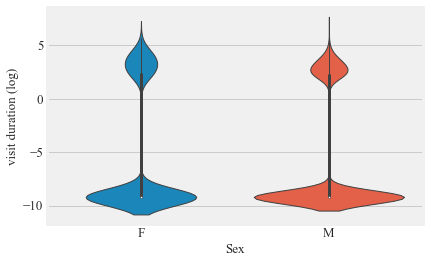
data.visit_duration.describe()
count 59050
mean 0 days 00:00:07.291244
std 0 days 00:00:17.425316
min 0 days 00:00:00
25% 0 days 00:00:00
50% 0 days 00:00:00
75% 0 days 00:00:10
max 0 days 00:10:15
Name: visit_duration, dtype: object
plt.hist(Bird_summary.duration_total)
plt.show()
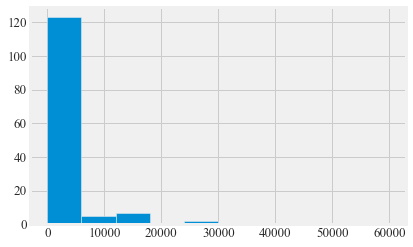
Bird_summary.duration_total.describe()
count 141.000000
mean 3053.531915
std 8455.482026
min 0.000000
25% 0.000000
50% 0.000000
75% 1331.000000
max 59922.000000
Name: duration_total, dtype: float64
Short visits
v_s = v[v.visit_duration =='0 seconds']
v_s.shape
(48713, 17)
v_s.visit_duration.sum()
Timedelta('0 days 00:00:00')
Long visits
v_d = v[v.visit_duration>'0 seconds']
v_d.shape
(16763, 17)
Total time observed
v_d.visit_duration.sum()
Timedelta('5 days 05:01:30')
sns.violinplot(v_d.Sex,np.log((v_d.visit_duration / np.timedelta64(1, 's')).astype(int)+0.0001), cut=0)
plt.ylabel('visit duration (log)')
plt.show()

difference in the visit duration males vs females
Bird_summary.Sex.unique()
array([u'F', u'M'], dtype=object)
v_d.head()
| visit_start | visit_end | ID | Tag | visit_duration | SrNo. | Tagged Date | Location Id | Tag Hex | Tag Dec | Species | Age | Sex | Band Number | Location | Notes | True Unknowns | |
|---|---|---|---|---|---|---|---|---|---|---|---|---|---|---|---|---|---|
| 274 | 2017-10-10 10:06:29 | 2017-10-10 10:06:40 | 3D6.00184967A1 | A1 | 00:00:11 | 16.0 | 2016-09-23 | SB | 3D6.00184967A1 | 982.000407 | ANHU | HY | F | NaN | Manfreds | NaN | NaN |
| 278 | 2017-10-10 10:08:17 | 2017-10-10 10:08:27 | 3D6.00184967A1 | A1 | 00:00:10 | 16.0 | 2016-09-23 | SB | 3D6.00184967A1 | 982.000407 | ANHU | HY | F | NaN | Manfreds | NaN | NaN |
| 280 | 2017-10-10 11:15:46 | 2017-10-10 11:15:56 | 3D6.00184967A1 | A1 | 00:00:10 | 16.0 | 2016-09-23 | SB | 3D6.00184967A1 | 982.000407 | ANHU | HY | F | NaN | Manfreds | NaN | NaN |
| 282 | 2017-10-10 11:19:53 | 2017-10-10 11:20:25 | 3D6.00184967A1 | A1 | 00:00:32 | 16.0 | 2016-09-23 | SB | 3D6.00184967A1 | 982.000407 | ANHU | HY | F | NaN | Manfreds | NaN | NaN |
| 284 | 2017-10-10 11:46:45 | 2017-10-10 11:46:56 | 3D6.00184967A1 | A1 | 00:00:11 | 16.0 | 2016-09-23 | SB | 3D6.00184967A1 | 982.000407 | ANHU | HY | F | NaN | Manfreds | NaN | NaN |
v_d['visit_duration_seconds'] = v_d['visit_duration'].dt.total_seconds()
trial = v_d.groupby(['ID', 'Sex']).visit_duration_seconds.mean()
trial = pd.DataFrame(trial)
trial.columns = ['duration_mean']
trial.reset_index(inplace= True)
trial.head()
C:\Users\Falco\Anaconda2\lib\site-packages\ipykernel_launcher.py:1: SettingWithCopyWarning:
A value is trying to be set on a copy of a slice from a DataFrame.
Try using .loc[row_indexer,col_indexer] = value instead
See the caveats in the documentation: http://pandas.pydata.org/pandas-docs/stable/indexing.html#indexing-view-versus-copy
"""Entry point for launching an IPython kernel.
| ID | Sex | duration_mean | |
|---|---|---|---|
| 0 | 3D6.00184967A1 | F | 43.838710 |
| 1 | 3D6.00184967A2 | F | 40.178049 |
| 2 | 3D6.00184967A4 | M | 27.726704 |
| 3 | 3D6.00184967A6 | M | 21.397590 |
| 4 | 3D6.00184967A7 | F | 21.530667 |
m_v_d1 = trial[trial.Sex== 'M']
m_v_d = m_v_d1.duration_mean #/ np.timedelta64(1, 's')
f_v_d1 = trial[trial.Sex== 'F']
f_v_d = f_v_d1.duration_mean #/ np.timedelta64(1, 's')
print (np.mean(f_v_d), np.std(f_v_d), len(f_v_d) )
(25.110059470897557, 11.969362949243743, 25)
print (np.mean(m_v_d), np.std(m_v_d), len(m_v_d) )
(23.43185166728472, 11.273722727146934, 45)
stats.kruskal(m_v_d, f_v_d)
KruskalResult(statistic=0.25264184738533463, pvalue=0.6152209840639247)
Comparison of median
stats.median_test(f_v_d, m_v_d)
(0.24888888888888888, 0.6178585337664037, 21.76533333333333, array([[14, 21],
[11, 24]], dtype=int64))
print 'male median visit time '+ str( np.median(m_v_d))
print 'female median visit time '+ str( np.median(f_v_d))
male median visit time 21.233055885850177
female median visit time 22.832512315270936
print 'male mean visit time '+ str( np.mean(m_v_d))
print 'female means visit time '+ str( np.mean(f_v_d))
male mean visit time 23.4318516673
female means visit time 25.1100594709
print 'male std visit time '+ str( np.std(m_v_d))
print 'female std visit time '+ str( np.std(f_v_d))
male std visit time 11.2737227271
female std visit time 11.9693629492
print 'male std visit time '+ str( m_v_d.shape)
print 'female std visit time '+ str( f_v_d.shape)
male std visit time (45L,)
female std visit time (25L,)
Proportoin of time present
Bird_summary['proportion_present'] = Bird_summary.duration_total/(Bird_summary.date_u*86400)
Bird_summary['proportion_present'].describe()
sns.boxplot(Bird_summary.Sex,Bird_summary.proportion_present)
plt.show()

m_pt = Bird_summary[Bird_summary.Sex== 'M']
f_pt = Bird_summary[Bird_summary.Sex== 'F']
stats.mannwhitneyu(m_pt.proportion_present, f_pt.proportion_present)
MannwhitneyuResult(statistic=2252.5, pvalue=0.45957163430402526)
m_pt.proportion_present.describe()
count 91.000000
mean 0.000651
std 0.001232
min 0.000000
25% 0.000000
50% 0.000000
75% 0.001028
max 0.007655
Name: proportion_present, dtype: float64
f_pt.proportion_present.describe()
count 50.000000
mean 0.000731
std 0.001580
min 0.000000
25% 0.000000
50% 0.000006
75% 0.000628
max 0.007378
Name: proportion_present, dtype: float64
Bird_summary.proportion_present.describe()
count 141.000000
mean 0.000680
std 0.001361
min 0.000000
25% 0.000000
50% 0.000000
75% 0.000874
max 0.007655
Name: proportion_present, dtype: float64
Diel activity of Humminbirds
Figure 7:
Diel plots of mean hourly hummingbird visits to the feeding stations at three sites at northern and southern California from September 2016 to March 2018. The bar denotes the mean hourly visits by hummingbirds and black lines show the standard error. All distributions were statistically non-uniform (probability values reported by season).
%%time
plt.rcParams['xtick.major.pad']='8'
HT.diurnal_variation(dataframe = data, output_path = output_path, species = 'all', sex = 'both', rlim = 1)
C:\Users\Falco\Anaconda2\lib\site-packages\matplotlib\projections\polar.py:58: RuntimeWarning: invalid value encountered in less
mask = r < 0

Rayleigh test identify a non-uniform distribution, i.e. it is
designed for detecting an unimodal deviation from uniformity
winter: p = 0.000
spring: p = 0.000
summer: p = 0.000
fall: p = 0.000
Wall time: 24.3 s
%%time
plt.rcParams['xtick.major.pad']='8'
HT.diurnal_variation(dataframe = data, output_path = output_path, species = 'ANHU', sex = 'both', rlim = 1)
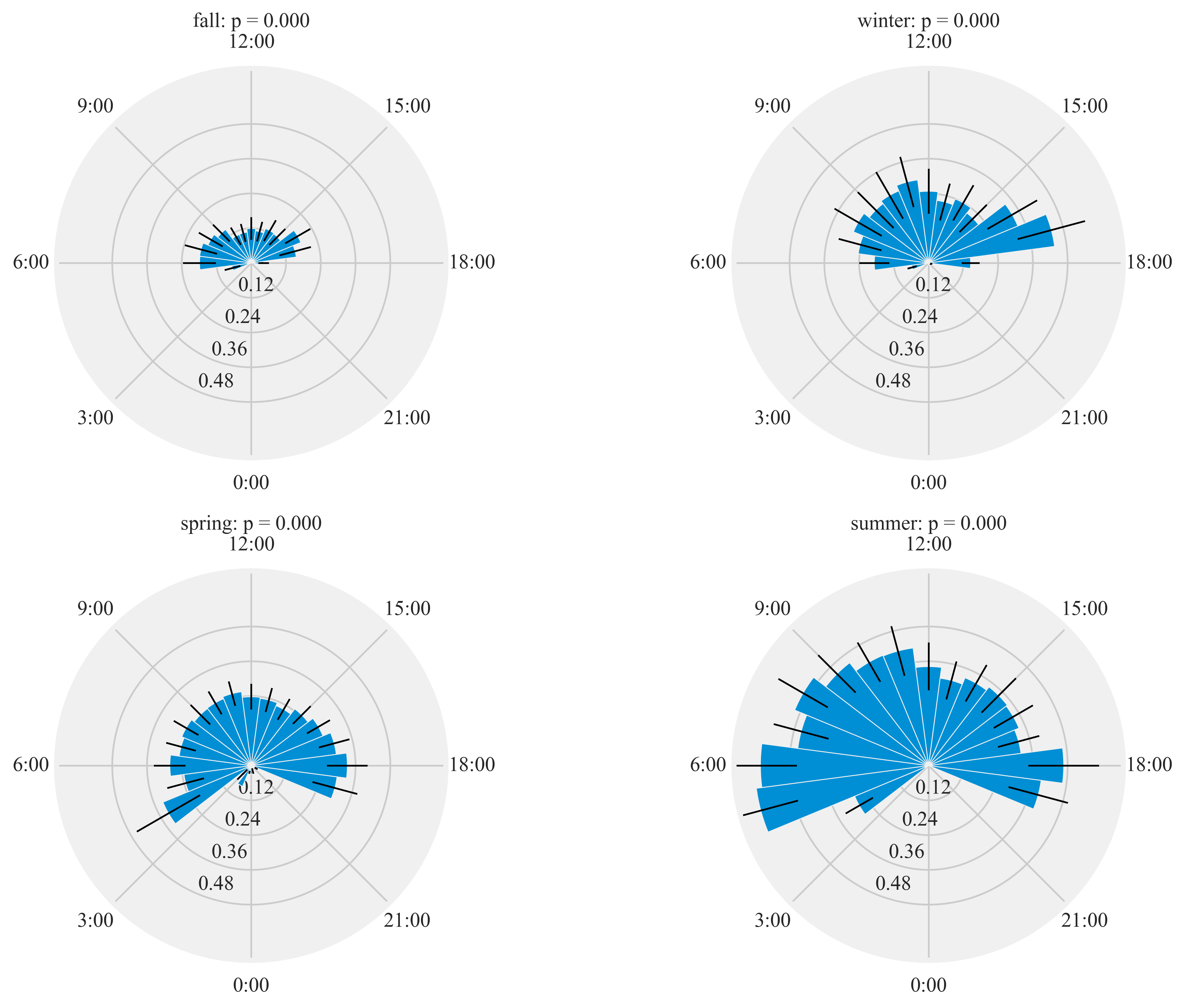
Rayleigh test identify a non-uniform distribution, i.e. it is
designed for detecting an unimodal deviation from uniformity
winter: p = 0.000
spring: p = 0.000
summer: p = 0.000
fall: p = 0.000
Wall time: 18.9 s
data[data.Sex =='M'].visit_start.max().date()
datetime.date(2018, 3, 31)
data[data.Species =='ANHU'].visit_start.max().date()
datetime.date(2018, 3, 31)
data[data.Sex =='M'].Date.max()
datetime.date(2018, 3, 31)
%%time
plt.rcParams['xtick.major.pad']='8'
HT.diurnal_variation(dataframe = data, output_path = output_path, species = 'ANHU', sex = 'F', rlim = 1)
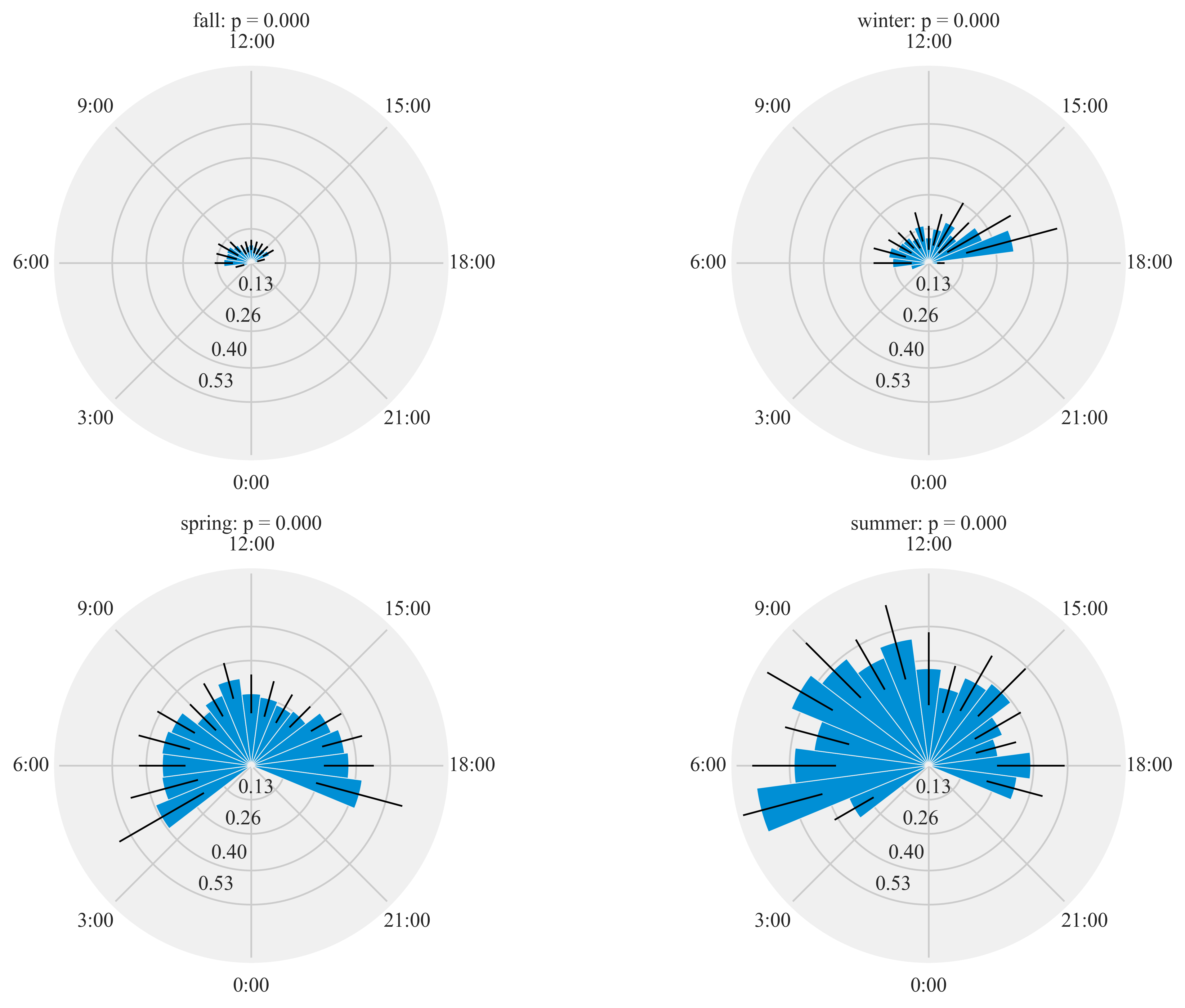
Rayleigh test identify a non-uniform distribution, i.e. it is
designed for detecting an unimodal deviation from uniformity
winter: p = 0.000
spring: p = 0.000
summer: p = 0.000
fall: p = 0.000
Wall time: 12.6 s
%%time
plt.rcParams['xtick.major.pad']='8'
HT.diurnal_variation(dataframe = data, output_path = output_path, species = 'ANHU', sex = 'M', rlim = 1)

Rayleigh test identify a non-uniform distribution, i.e. it is
designed for detecting an unimodal deviation from uniformity
winter: p = 0.000
spring: p = 0.000
summer: p = 0.000
fall: p = 0.000
Wall time: 14.6 s
%%time
plt.rcParams['xtick.major.pad']='8'
HT.diurnal_variation(dataframe = data, output_path = output_path, species = 'ALHU', sex = 'both', rlim = 0.1)
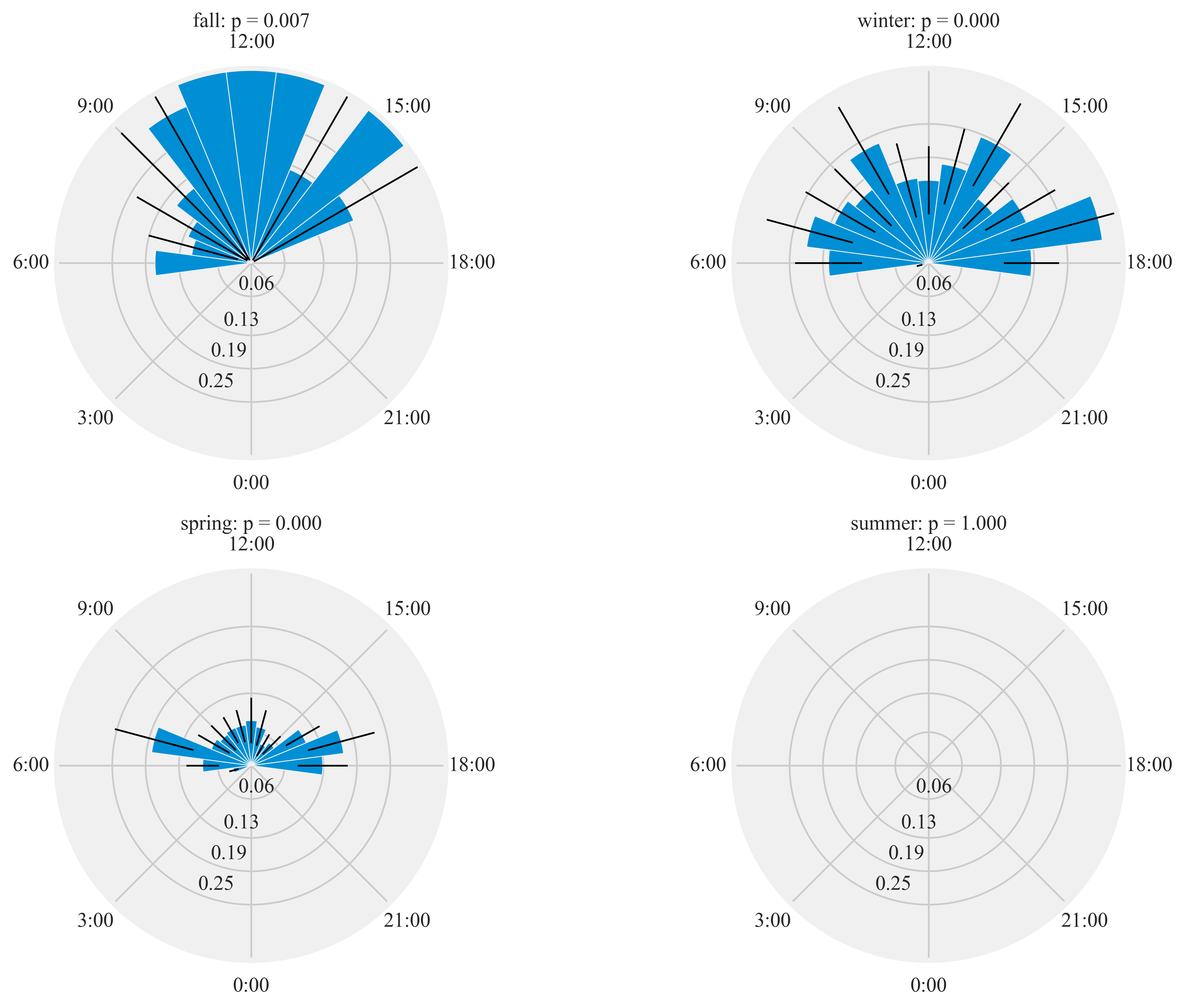
Rayleigh test identify a non-uniform distribution, i.e. it is
designed for detecting an unimodal deviation from uniformity
winter: p = 0.000
spring: p = 0.000
summer: p = 1.000
fall: p = 0.007
Wall time: 11.6 s
%%time
plt.rcParams['xtick.major.pad']='8'
HT.diurnal_variation(dataframe = data, output_path = output_path, species = 'ALHU', sex = 'M', rlim = 0.1)

Rayleigh test identify a non-uniform distribution, i.e. it is
designed for detecting an unimodal deviation from uniformity
winter: p = 0.000
spring: p = 0.000
summer: p = 1.000
fall: p = 0.007
Wall time: 10.9 s
%%time
plt.rcParams['xtick.major.pad']='8'
HT.diurnal_variation(dataframe = data, output_path = output_path, species = 'ALHU', sex = 'F', rlim = 0.1)
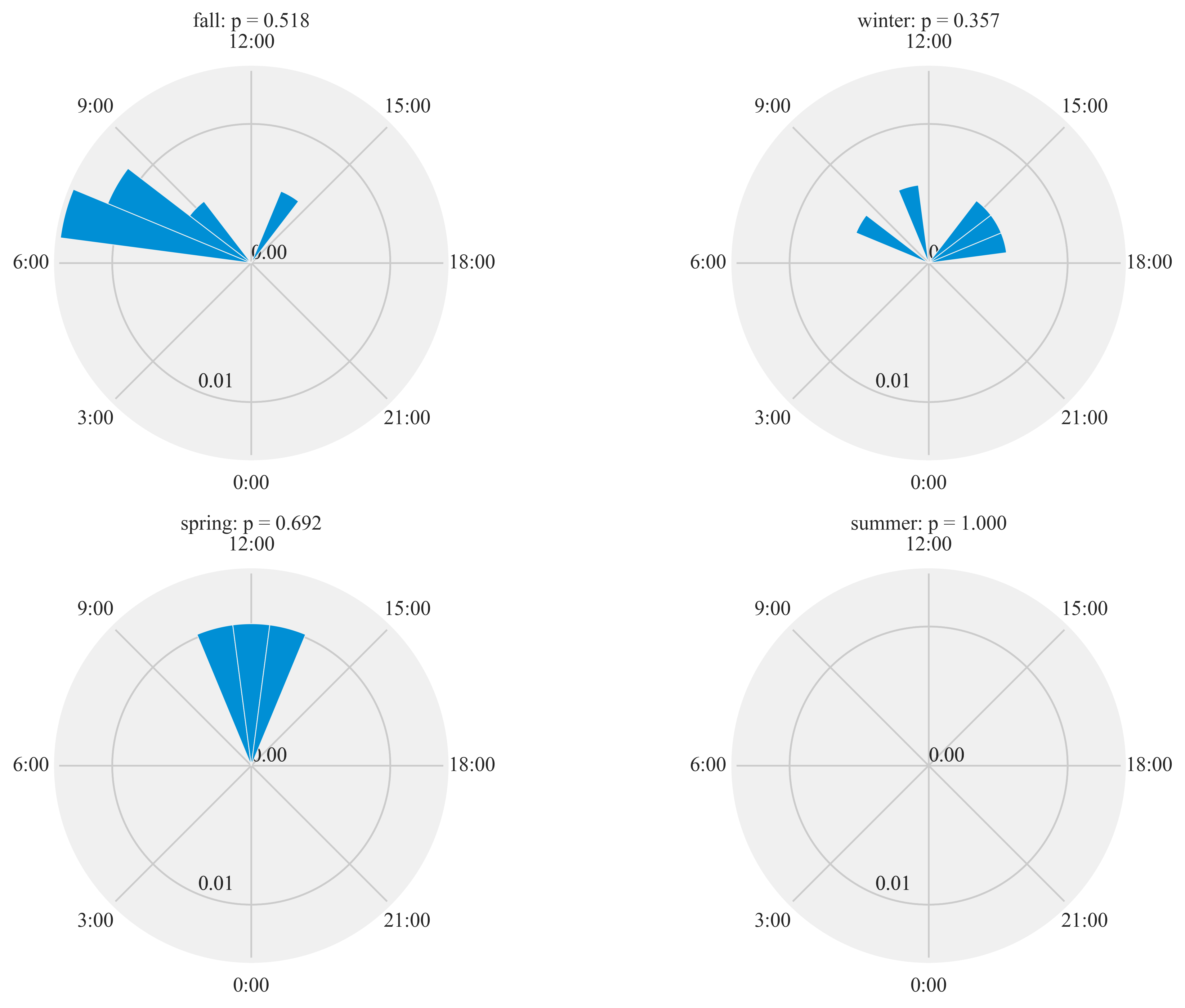
Rayleigh test identify a non-uniform distribution, i.e. it is
designed for detecting an unimodal deviation from uniformity
winter: p = 0.357
spring: p = 0.692
summer: p = 1.000
fall: p = 0.518
Wall time: 10.3 s
bird_summaries
This function:
- calculates summaries for each tagged bird
- save a csv file with summary output
- columns are
Tag Hex,Species,Sex, Age, tagged_date, first_obs_aft_tag, date_min, date_max, obser_period, date_u, Location
Night time activity
Birds that showed activity between 10 PM to 4 AM
visit_data.set_index(pd.DatetimeIndex(visit_data['visit_start']), inplace= True)
import datetime
start = datetime.time(22,0,0)
end = datetime.time(4,0,0)
visit_data.between_time(start, end).ID.unique().tolist()
['3D6.00184967A4',
'3D6.00184967A7',
'3D6.00184967AD',
'3D6.00184967AF',
'3D6.00184967BC',
'3D6.00184967BF',
'3D6.1D593D7848']
number of visits in night by birds
import numpy as np
n = visit_data.between_time(start, end)
n['date']= n.index.date
n.groupby(['ID', 'date']).visit_start.count()
C:\Users\Falco\Anaconda2\lib\site-packages\ipykernel_launcher.py:3: SettingWithCopyWarning:
A value is trying to be set on a copy of a slice from a DataFrame.
Try using .loc[row_indexer,col_indexer] = value instead
See the caveats in the documentation: http://pandas.pydata.org/pandas-docs/stable/indexing.html#indexing-view-versus-copy
This is separate from the ipykernel package so we can avoid doing imports until
ID date
3D6.00184967A4 2018-01-04 3
2018-01-06 1
3D6.00184967A7 2017-06-19 1
3D6.00184967AD 2017-05-22 2
2017-05-23 11
2017-05-24 7
2017-05-25 4
3D6.00184967AF 2017-05-23 2
2017-05-24 3
2017-05-25 1
2018-01-05 3
2018-01-06 1
3D6.00184967BC 2017-06-19 1
3D6.00184967BF 2018-01-04 1
2018-02-10 1
3D6.1D593D7848 2018-02-13 1
Name: visit_start, dtype: int64
n.describe()
| visit_duration | |
|---|---|
| count | 43 |
| mean | 0 days 00:00:06.488372 |
| std | 0 days 00:00:14.921017 |
| min | 0 days 00:00:00 |
| 25% | 0 days 00:00:00 |
| 50% | 0 days 00:00:00 |
| 75% | 0 days 00:00:00 |
| max | 0 days 00:01:05 |
date_format='%H:%M:%S'
Time spent at the feeder in a night
n.groupby(['ID', 'date']).visit_duration.sum()
ID date
3D6.00184967A4 2018-01-04 00:01:27
2018-01-06 00:00:00
3D6.00184967A7 2017-06-19 00:00:43
3D6.00184967AD 2017-05-22 00:00:00
2017-05-23 00:00:00
2017-05-24 00:00:00
2017-05-25 00:00:00
3D6.00184967AF 2017-05-23 00:00:00
2017-05-24 00:00:00
2017-05-25 00:00:00
2018-01-05 00:01:14
2018-01-06 00:00:00
3D6.00184967BC 2017-06-19 00:01:05
3D6.00184967BF 2018-01-04 00:00:00
2018-02-10 00:00:10
3D6.1D593D7848 2018-02-13 00:00:00
Name: visit_duration, dtype: timedelta64[ns]
feeders used in night
n.groupby(['ID', 'date'])['Tag'].unique()
ID date
3D6.00184967A4 2018-01-04 [A4]
2018-01-06 [A4]
3D6.00184967A7 2017-06-19 [A4]
3D6.00184967AD 2017-05-22 [A4]
2017-05-23 [A4]
2017-05-24 [A4]
2017-05-25 [A4]
3D6.00184967AF 2017-05-23 [A4]
2017-05-24 [A4]
2017-05-25 [A4]
2018-01-05 [A4]
2018-01-06 [A4]
3D6.00184967BC 2017-06-19 [A4]
3D6.00184967BF 2018-01-04 [A4]
2018-02-10 [A5]
3D6.1D593D7848 2018-02-13 [A5]
Name: Tag, dtype: object
from matplotlib import dates as dates
import datetime as datetime
from matplotlib.ticker import MaxNLocator
Figure 8:
Activity of an after hatch year male Anna’s hummingbird with a subcutaneously placed PIT at Site 2 between May 22nd and May 26th 2017. This bird was detected at the feeder after sunset, evident in the peaks of hourly visits during the night (green shaded sections of plot).
f, (ax1) = plt.subplots(1, 1, figsize=(8,6))
HT.plotBirdnight(data = visit_data, bird_ID='3D6.00184967AD',
start = '2017-05-22',
end ='2017-05-26',Bird_summary_data= Bird_summary, ax = ax1)
#f.suptitle('Hummingbird visits to feeders', fontsize = 24)
f.tight_layout()#rect=[0, 0.03, 1, 0.95]
f.savefig(output_path+'/Figure 7.png', dpi = dpi)
f.savefig(output_path+'/Figure 7.eps',format = 'eps', dpi=dpi)
plt.show()

Figure S1:
Activity of PIT tagged Anna’s Hummingbirds (Calypte anna) detected between 10 PM to 4 AM for the study period (September 2016- March 2018). This nocturnal activity was only seen at study site 2 in northern California. The shaded portion represents night time. Days preceding and succeeding the night
fig, ((ax1,ax2,ax3),(ax4,ax5,ax6), (ax7,ax8,ax9)) = plt.subplots(nrows = 3, ncols = 3, figsize = (11,11))
HT.plotBirdnight(data = visit_data, bird_ID='3D6.00184967A4',
start = '2018-01-04',
end ='2018-01-07',Bird_summary_data= Bird_summary, ax = ax1, title = True)
HT.plotBirdnight(data = visit_data, bird_ID='3D6.00184967A7',
start = '2017-06-18',
end ='2017-06-20',Bird_summary_data= Bird_summary, ax = ax2,title = True)
HT.plotBirdnight(data = visit_data, bird_ID='3D6.00184967AD',
start = '2017-05-22',
end ='2017-05-26',Bird_summary_data= Bird_summary, ax = ax3,title = True)
HT.plotBirdnight(data = visit_data, bird_ID='3D6.00184967AF',
start = '2017-05-22',
end ='2017-05-26',Bird_summary_data= Bird_summary, ax = ax4,title = True)
HT.plotBirdnight(data = visit_data, bird_ID='3D6.00184967AF',
start = '2018-01-05',
end ='2018-01-07',Bird_summary_data= Bird_summary, ax = ax5,title = True)
HT.plotBirdnight(data = visit_data, bird_ID='3D6.00184967BC',
start = '2017-06-18',
end ='2017-06-20',Bird_summary_data= Bird_summary, ax = ax6,title = True)
HT.plotBirdnight(data = visit_data, bird_ID='3D6.00184967BF',
start = '2018-01-04',
end ='2018-01-06',Bird_summary_data= Bird_summary, ax = ax7,title = True)
HT.plotBirdnight(data = visit_data, bird_ID='3D6.00184967BF',
start = '2018-02-09',
end ='2018-02-11',Bird_summary_data= Bird_summary, ax = ax8,title = True)
HT.plotBirdnight(data = visit_data, bird_ID='3D6.1D593D7848',
start = '2018-02-12',
end ='2018-02-14',Bird_summary_data= Bird_summary, ax = ax9,title = True)
plt.tight_layout()
plt.savefig(output_path+'/Figure S3.png', dpi = dpi)
plt.savefig(output_path+'/Figure S3.eps',format = 'eps', dpi=dpi)
plt.show()
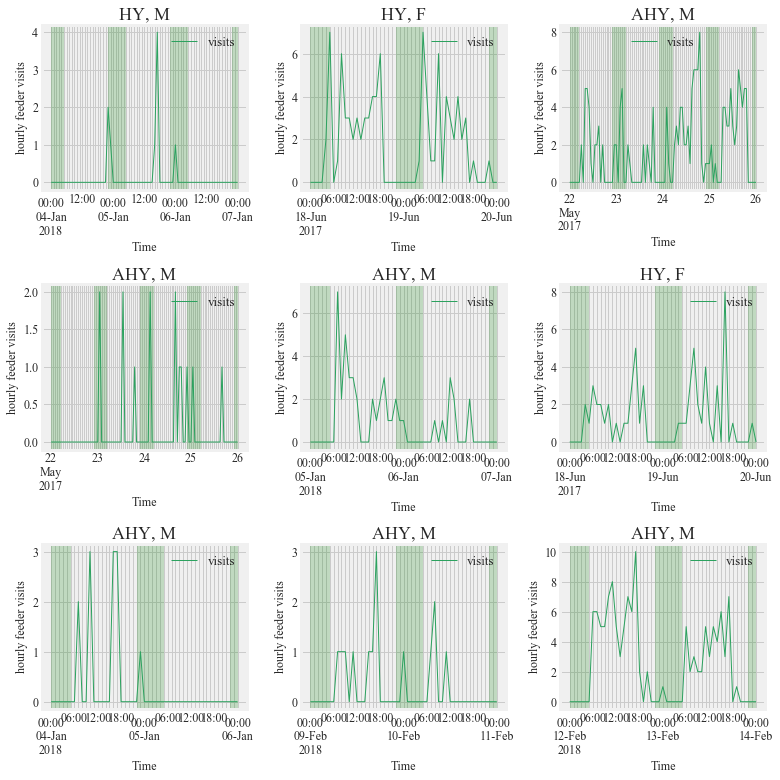
Feeder preference
Figure 9:
The preference of individual Anna’s and Allen’s Hummingbirds for the primary, secondary, and tertiary feeders in Site 2 in Northern California. Solid circles show the data points.
reader_predilection.columns =reader_predilection.columns.get_level_values(0)
t = reader_predilection.drop('A1', axis=1)
#t.set_index('ID',inplace= True)
primary = []
secondary = []
tertiary = []
bird = []
for index,row in t.iterrows():
if row.values.max() !=0:
r = sorted(row.values, reverse= True)
total = float(row.values.sum())
bird.append(index)
primary.append(r[0]/total)
secondary.append(r[1]/total)
tertiary.append(r[2]/total)
r_p = pd.DataFrame({'primary':primary,'secondary':secondary,'tertiary':tertiary}, index=bird)
r_p = r_p*100
###################################################################################################
###################################################################################################
#r_p.head()
t = t[(t.T != 0).any()]
t.idxmax(axis=1).value_counts()
###################################################################################################
###################################################################################################
primary = []
secondary = []
tertiary = []
bird = []
for index,row in t.iterrows():
if row.values.max() !=0:
r = sorted(row.values, reverse= True)
total = float(row.values.sum())
bird.append(index)
primary.append(r[0]/total)
secondary.append(r[1]/total)
tertiary.append(r[2]/total)
###################################################################################################
###################################################################################################
import seaborn as sns
f, (ax1) = plt.subplots(1, 1, figsize=(8,6))
sns.boxplot(x="variable", y="value", data=r_p.melt(), ax = ax1)
ax = sns.swarmplot(x="variable", y="value", data=r_p.melt(), color=".25", ax = ax1)
ax1.set_xlabel('feeders')
ax1.set_ylabel('% feeder visits')
ax1.text(1, 85, r'Kruskal-Wallis, p<$2.2e^{-16}$')
f.tight_layout()#rect=[0, 0.03, 1, 0.95]
f.savefig(output_path+'/Figure 8.png', dpi = dpi)
f.savefig(output_path+'/Figure 8.eps',format = 'eps', dpi=dpi)
plt.show()

r_p.describe()
| primary | secondary | tertiary | |
|---|---|---|---|
| count | 109.000000 | 109.000000 | 109.000000 |
| mean | 86.674542 | 10.809845 | 2.515613 |
| std | 19.231371 | 15.635133 | 6.478267 |
| min | 33.333333 | 0.000000 | 0.000000 |
| 25% | 73.317308 | 0.000000 | 0.000000 |
| 50% | 100.000000 | 0.000000 | 0.000000 |
| 75% | 100.000000 | 21.875000 | 0.144509 |
| max | 100.000000 | 50.000000 | 33.333333 |
Interactions contact network
interactions = Hxnet.get_intreactions(data=data)
interactions.shape
(1635, 28)
print ('there were '+ str(interactions.shape[0])+' interactions observed during the study period')
there were 1635 interactions observed during the study period
Hnet = Hxnet.get_interaction_networks(network_name='hummingbirds', data = data,
interactions = interactions,
location = output_path)
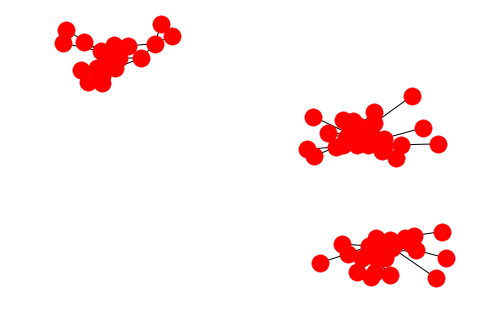
import networkx as nx
nx.write_graphml(Hnet, output_path +'/'+ "hummingbirds_interaction.graphml")
from taggit import interactions as Hxnet
a = data.groupby(['ID', 'Sex', 'Age', 'Location', 'Species']).size().reset_index().rename(columns={0:'count'})
from fa2 import ForceAtlas2
forceatlas2 = ForceAtlas2(
# Behavior alternatives
outboundAttractionDistribution=False, # Dissuade hubs
linLogMode=False, # NOT IMPLEMENTED
adjustSizes=False, # Prevent overlap (NOT IMPLEMENTED)
edgeWeightInfluence=0.5,
# Performance
jitterTolerance=1.0, # Tolerance
barnesHutOptimize=True,
barnesHutTheta=1.2,
multiThreaded=False, # NOT IMPLEMENTED
# Tuning
scalingRatio=1.0,
strongGravityMode=False,
gravity=5.0,
# Log
verbose=True)
Figure 10: (Manuscript has a figure generated using Gephi)
Contact network of tagged Anna’s (pink nodes) and Allen’s hummingbirds (green nodes). The sex of the hummingbirds indicated by M for males and F for females. The size of the node is proportional to the degree of the interaction. Edges represent time spent together at the feeding station and the width of the edge width is proportional to the time spent together.
color_map = {"ANHU":'#e41a1c', "ALHU":'#377eb8'}
plt.figure(figsize=(25,25))
options = {
'edge_color': '#999994',
'font_weight': 'regular',
'label': True,
'alpha': 0.8
}
colors = [color_map[Hnet.node[node]['Species']] for node in Hnet]
#sizes = [G.node[node]['nodesize']*10 for node in G]
w = nx.get_edge_attributes(Hnet,'weight').values()
w2 = [x -1 for x in w]
s = [1000+(10000*np.log2(x+1))+(np.log2(np.log2(x+1)+1)*10000) for x in nx.betweenness_centrality(Hnet,).values()]
l = nx.get_node_attributes(Hnet, 'Sex').values()
mapping=nx.get_node_attributes(Hnet, 'Sex')
#Hnet=nx.relabel_nodes(Hnet,mapping)
"""
Using the spring layout :
- k controls the distance between the nodes and varies between 0 and 1
- iterations is the number of times simulated annealing is run
default k=0.1 and iterations=50
"""
positions = forceatlas2.forceatlas2_networkx_layout(Hnet, pos=None, iterations=2000)
nx.draw(Hnet, node_color=colors, node_size=s, pos=positions, width = w, **options)
nx.draw_networkx_labels(Hnet,positions,mapping,font_size=24)
ax = plt.gca()
ax.collections[0].set_edgecolor("#555555")
plt.savefig(output_path+'/Network_diagram.png', dpi = dpi)
plt.savefig(output_path+'/Network_diagram.eps', format = 'eps', dpi = dpi)
plt.show()
100%|████████████████████████████████████████████████████████████████████████████| 2000/2000 [00:00<00:00, 2148.23it/s]
('BarnesHut Approximation', ' took ', '0.20', ' seconds')
('Repulsion forces', ' took ', '0.55', ' seconds')
('Gravitational forces', ' took ', '0.01', ' seconds')
('Attraction forces', ' took ', '0.06', ' seconds')
('AdjustSpeedAndApplyForces step', ' took ', '0.05', ' seconds')
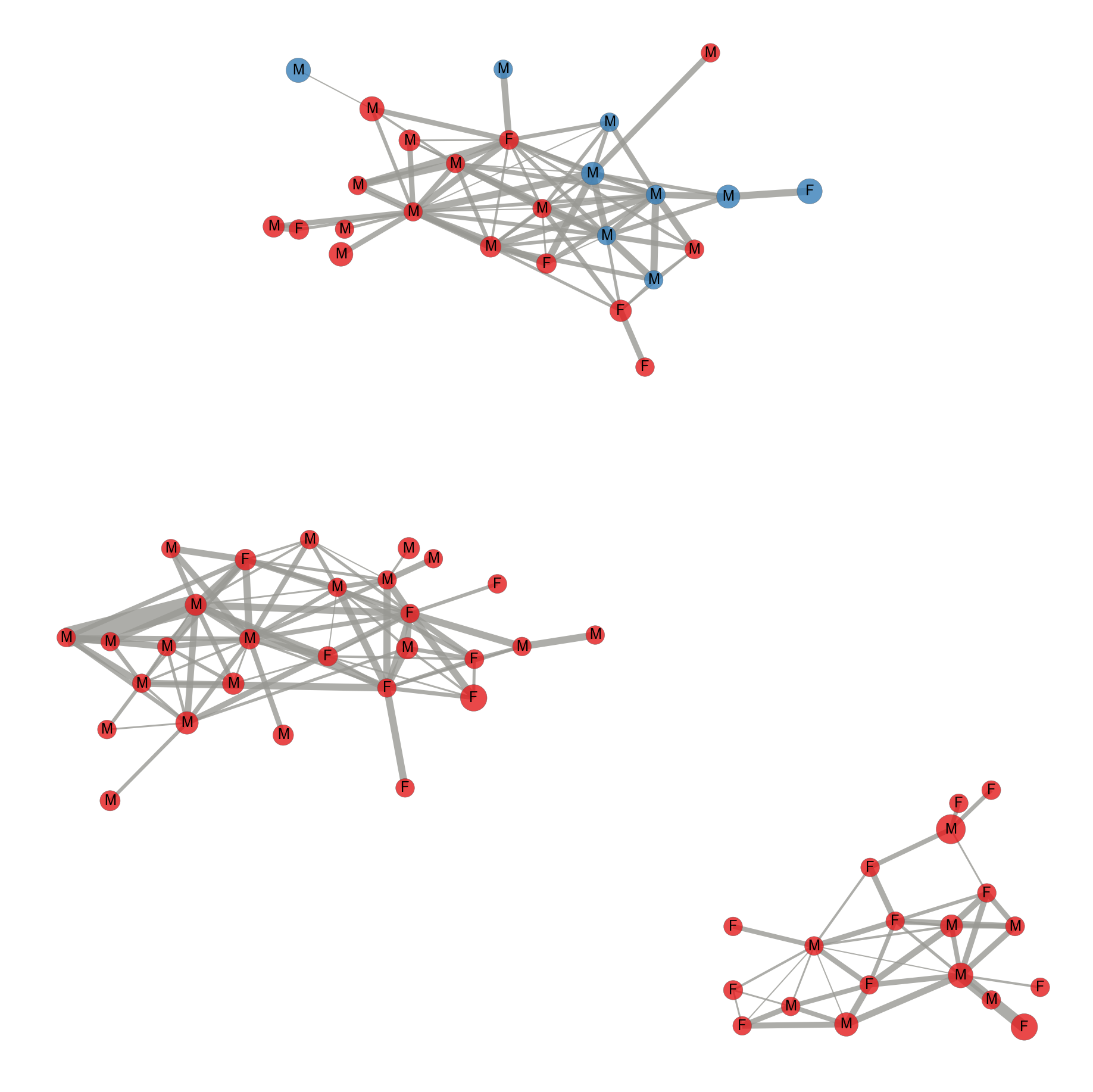
Analysis for comparing degree distrbutions
Figure S2:
Results of permutation-based regression analysis to understand the effect of age and sex on the degree of in the observed network. Blue lines show the distribution of coefficients after 10,000 permutations. Red lines show original coefficients.
%%time
Hxnet.run_permutation_test(dependent='degree', network= Hnet, number_of_permutations = 10000, output_path = output_path)
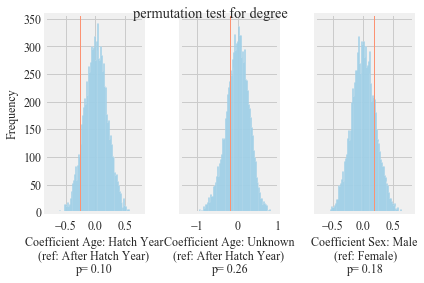
Wall time: 1min 31s
Figure S3:
Results of permutation-based regression analysis to understand the effect of age and sex on the betweenness centrality of in the observed network. Blue lines show the distribution of coefficients after 10,000 permutations. Red lines show original coefficients.
%%time
Hxnet.run_permutation_test(dependent='centrality', network= Hnet, number_of_permutations = 10000, output_path = output_path)
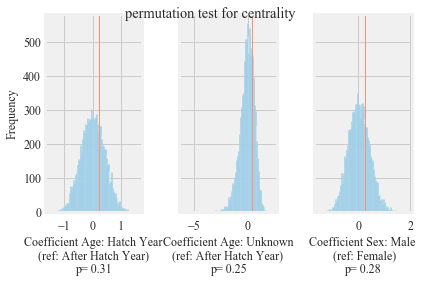
Wall time: 1min 21s
males = zip(*filter(lambda (n, d): d['Sex'] == 'M', Hnet.nodes(data=True)))[0]
females = zip(*filter(lambda (n, d): d['Sex'] == 'F', Hnet.nodes(data=True)))[0]
HY = zip(*filter(lambda (n, d): d['Age'] == 'HY', Hnet.nodes(data=True)))[0]
AHY = zip(*filter(lambda (n, d): d['Age'] == 'AHY', Hnet.nodes(data=True)))[0]
#####################################################################################
#####################################################################################
m_d = sorted(zip(*Hnet.degree(males))[1], reverse=True)
f_d = sorted(zip(*Hnet.degree(females))[1], reverse=True)
hy_d = sorted(zip(*Hnet.degree(HY))[1], reverse=True)
ahy_d = sorted(zip(*Hnet.degree(AHY))[1], reverse=True)
#####################################################################################
#####################################################################################
bc = nx.betweenness_centrality(Hnet)
males_bc = { m: bc[m] for m in males }
females_bc = { m: bc[m] for m in females }
AHY_bc = { m: bc[m] for m in AHY }
HY_bc = { m: bc[m] for m in HY }
degree = sorted(zip(*Hnet.degree(males))[1], reverse=True)
max(degree)
16
min(degree)
1
degree distbutions between males and females statistical comparison
stats.ks_2samp(m_d, f_d)
Ks_2sampResult(statistic=0.1883333333333333, pvalue=0.5583719606128525)
degree distbutions between hatch year and after hatch years statistical comparison
stats.ks_2samp(hy_d, ahy_d)
Ks_2sampResult(statistic=0.21169354838709678, pvalue=0.433553562913418)
betweenness centrality males and females years statistical comparison
stats.ks_2samp(males_bc.values(), females_bc.values())
Ks_2sampResult(statistic=0.16416666666666674, pvalue=0.7282154106780466)
betweenness centrality hatch year and after hatch years statistical comparison
stats.ks_2samp(AHY_bc.values(), HY_bc.values())
Ks_2sampResult(statistic=0.09173387096774188, pvalue=0.9988423204076042)
Figure 10:
Contact network of tagged Anna’s (pink nodes) and Allen’s hummingbirds (green nodes). The sex of the hummingbirds indicated by M for males and F for females. The size of the node is proportional to the degree of the interaction. Edges represent time spent together at the feeding station and the width of the edge width is proportional to the time spent together.
f, ((ax1, ax2), (ax3, ax4)) = plt.subplots(2, 2, figsize = (8,8))
ax1.loglog(m_d, 'b-', marker='o', label = 'males')
ax1.loglog(f_d, 'r-', marker='o', label = 'females')
ax1.legend()
ax1.set_ylabel("degree")
ax1.set_xlabel("rank")
ax2.loglog(hy_d, 'b-', marker='o', label = 'hatch year')
ax2.loglog(ahy_d, 'r-', marker='o', label = 'after hatch years')
ax2.legend()
ax2.set_ylabel("degree")
ax2.set_xlabel("rank")
ax3.loglog(sorted (males_bc.values(), reverse= True), 'b-', marker='o', label = 'males')
ax3.loglog(sorted (females_bc.values(), reverse= True), 'r-', marker='o', label = 'females')
ax3.legend()
ax3.set_ylabel("betweenness centrality")
ax3.set_xlabel("rank")
ax4.loglog(sorted (HY_bc.values(), reverse= True), 'b-', marker='o', label = 'hatch year')
ax4.loglog(sorted (AHY_bc.values(), reverse= True), 'r-', marker='o', label = 'after hatch years')
ax4.legend()
ax4.set_ylabel("betweenness centrality")
ax4.set_xlabel("rank")
plt.tight_layout()
plt.savefig(output_path+'/Figure 10.png', dpi= dpi)
plt.savefig(output_path+'/Figure 10.eps',format= 'eps', dpi= dpi)
plt.show()

Table 6
i = list(pd.unique(interactions[['ID', 'second_bird']].values.ravel('K')))
interacted_birds = meta[meta['Tag Hex'].isin(i)]
inter = pd.pivot_table(data=interacted_birds, index='Species', columns=['Sex', 'Age'] , aggfunc= 'count', values='Tag Hex', fill_value=0, margins= True)
inter
| Sex | F | M | All | ||||
|---|---|---|---|---|---|---|---|
| Age | AHY | HY | UNK | AHY | HY | UNK | |
| Species | |||||||
| ALHU | 0 | 0 | 1 | 3 | 1 | 4 | 9 |
| ANHU | 10 | 14 | 0 | 18 | 17 | 5 | 64 |
| All | 10 | 14 | 1 | 21 | 18 | 9 | 73 |
pd.pivot_table(data=interacted_birds, index='Species', columns='Sex' , aggfunc= 'count', values='Tag Hex', fill_value=0, margins= True)
| Sex | F | M | All |
|---|---|---|---|
| Species | |||
| ALHU | 1 | 8 | 9 |
| ANHU | 24 | 40 | 64 |
| All | 25 | 48 | 73 |
Types of interactions
m2 = meta[['Tag Hex', 'Species', 'Age', 'Sex']]
m2.columns = ['second_bird', 'Species2', 'Age2', 'Sex2']
i2 = pd.merge(interactions, m2, on='second_bird', how='left')
def returnTypeInt (c):
if [(c.Sex == 'M') & (c.Sex2 == 'M')]:
return 'MM'
elif [(c.Sex == 'M') & (c.Sex2 == 'F')]:
return 'MF'
elif [(c.Sex == 'F') & (c.Sex2 == 'M')]:
return 'MF'
elif [(c.Sex == 'F') & (c.Sex2 == 'F')]:
return 'FF'
else:
return 'Problem'
conditions = [
(i2['Sex'] == 'M') & (i2['Sex2'] == 'M'),
(i2['Sex'] == 'M') & (i2['Sex2'] == 'F'),
(i2['Sex'] == 'F') & (i2['Sex2'] == 'M'),
(i2['Sex'] == 'F') & (i2['Sex2'] == 'F')
]
choices = ['MM', 'MF', 'MF', 'FF']
i2['Type'] = np.select(conditions, choices, default='MM')
conditions2 = [
(i2['overlap'] <= 0),
(i2['overlap'] > 0)
]#(i2['overlap'] == 0)
choices = ['short_interactions', 'long_interactions'] #'medium_interactions',
i2['DurationType'] = np.select(conditions2, choices, default='short_interaction')
#i2['Type'] = i2.apply(returnTypeInt, axis=1)
i2['Type'].value_counts()
MM 1020
MF 491
FF 124
Name: Type, dtype: int64
#i2['Type'] = i2.apply(returnTypeInt, axis=1)
i2['Type'].value_counts()
MM 1020
MF 491
FF 124
Name: Type, dtype: int64
i2['DurationType'].value_counts()
short_interactions 1608
long_interactions 27
Name: DurationType, dtype: int64
inter_pv = pd.pivot_table(columns='DurationType', index='Type',data=i2, fill_value=0, aggfunc='count', values='ID')
inter_pv
| DurationType | long_interactions | short_interactions |
|---|---|---|
| Type | ||
| FF | 7 | 117 |
| MF | 4 | 487 |
| MM | 16 | 1004 |
i2.Age2.unique()
array([u'HY', u'AHY', u'UNK'], dtype=object)
conditions3 = [
(i2['Age'] == 'HY') & (i2['Age2'] == 'HY'),
(i2['Age'] == 'HY') & (i2['Age2'] == 'AHY'),
(i2['Age'] == 'HY') & (i2['Age2'] == 'UNK'),
(i2['Age'] == 'AHY') & (i2['Age2'] == 'HY'),
(i2['Age'] == 'AHY') & (i2['Age2'] == 'AHY'),
(i2['Age'] == 'AHY') & (i2['Age2'] == 'UNK'),
(i2['Age'] == 'UNK') & (i2['Age2'] == 'HY'),
(i2['Age'] == 'UNK') & (i2['Age2'] == 'AHY'),
(i2['Age'] == 'UNK') & (i2['Age2'] == 'UNK'),
]
choices = ['HyHy', 'HyAHy', 'HyUNK', 'HyAHy', 'AHyAHy', 'AHyUNK', 'HyUNK', 'AHyUNK', 'UNKUNK']
i2['TypeAge'] = np.select(conditions3, choices, default='UNKUNK')
i2['TypeAge'].value_counts()
HyHy 494
HyAHy 430
AHyAHy 303
AHyUNK 240
HyUNK 126
UNKUNK 42
Name: TypeAge, dtype: int64
age_pv = pd.pivot_table(columns='DurationType', index='TypeAge',data=i2, fill_value=0, aggfunc='count', values='ID')
age_pv
| DurationType | long_interactions | short_interactions |
|---|---|---|
| TypeAge | ||
| AHyAHy | 4 | 299 |
| AHyUNK | 2 | 238 |
| HyAHy | 8 | 422 |
| HyHy | 13 | 481 |
| HyUNK | 0 | 126 |
| UNKUNK | 0 | 42 |
i2.set_index(pd.DatetimeIndex(i2['visit_start']), inplace= True)
i2.groupby([ pd.Grouper(freq='M'), 'DurationType'])['ID'].count().unstack('DurationType').plot(kind="line", rot =45, stacked=False)
plt.show()
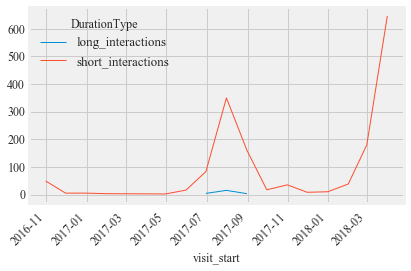
i2.groupby([ pd.Grouper(freq='M'), 'DurationType'])['ID'].count().unstack('DurationType')
| DurationType | long_interactions | short_interactions |
|---|---|---|
| visit_start | ||
| 2016-10-31 | NaN | 49.0 |
| 2016-11-30 | NaN | 5.0 |
| 2016-12-31 | NaN | 5.0 |
| 2017-01-31 | NaN | 3.0 |
| 2017-04-30 | NaN | 2.0 |
| 2017-05-31 | NaN | 16.0 |
| 2017-06-30 | 4.0 | 83.0 |
| 2017-07-31 | 15.0 | 350.0 |
| 2017-08-31 | 3.0 | 160.0 |
| 2017-09-30 | NaN | 17.0 |
| 2017-10-31 | NaN | 35.0 |
| 2017-11-30 | NaN | 8.0 |
| 2017-12-31 | NaN | 10.0 |
| 2018-01-31 | NaN | 38.0 |
| 2018-02-28 | NaN | 180.0 |
| 2018-03-31 | 5.0 | 647.0 |
i2['visit_start'] = pd.to_datetime(i2['visit_start'])
i2.set_index(pd.DatetimeIndex(i2['visit_start']), inplace= True)
multi_index = pd.MultiIndex.from_product([pd.date_range('2016-9-22', i2.visit_start.max().date(),freq='1H'), i2['DurationType'].unique()], names=['Date', 'DurationType'])
a = i2.groupby([ pd.Grouper(freq='1H'), 'DurationType'])['ID'].count().reindex(multi_index, fill_value=0).unstack('DurationType').reset_index()#.plot(kind="bar", rot =0, stacked=True).res
a['h'] = pd.to_datetime(a['Date'], format= '%H:%M:%S' ).dt.time
agg_funcs = {'long_interactions':[np.mean, 'sem'], 'short_interactions':[np.mean, 'sem']}
a = a.groupby(a.h).agg(agg_funcs).reset_index()
a.columns = a.columns.droplevel(0)
a.columns = ['hour', 'mean_long', 'sem_long', 'mean_short', 'sem_short',]
#a['hour'] = pd.to_datetime(a['hour'])
a = a.set_index(a['hour'])
a
| hour | mean_long | sem_long | mean_short | sem_short | |
|---|---|---|---|---|---|
| hour | |||||
| 00:00:00 | 00:00:00 | 0.000000 | 0.000000 | 0.000000 | 0.000000 |
| 01:00:00 | 01:00:00 | 0.000000 | 0.000000 | 0.000000 | 0.000000 |
| 02:00:00 | 02:00:00 | 0.000000 | 0.000000 | 0.000000 | 0.000000 |
| 03:00:00 | 03:00:00 | 0.000000 | 0.000000 | 0.000000 | 0.000000 |
| 04:00:00 | 04:00:00 | 0.003604 | 0.002546 | 0.030631 | 0.009624 |
| 05:00:00 | 05:00:00 | 0.003604 | 0.002546 | 0.172973 | 0.032830 |
| 06:00:00 | 06:00:00 | 0.000000 | 0.000000 | 0.214414 | 0.036315 |
| 07:00:00 | 07:00:00 | 0.000000 | 0.000000 | 0.194595 | 0.036293 |
| 08:00:00 | 08:00:00 | 0.007207 | 0.004407 | 0.227027 | 0.039977 |
| 09:00:00 | 09:00:00 | 0.005405 | 0.003115 | 0.108108 | 0.017625 |
| 10:00:00 | 10:00:00 | 0.001802 | 0.001802 | 0.138739 | 0.024082 |
| 11:00:00 | 11:00:00 | 0.001802 | 0.001802 | 0.149550 | 0.023829 |
| 12:00:00 | 12:00:00 | 0.001802 | 0.001802 | 0.131532 | 0.021293 |
| 13:00:00 | 13:00:00 | 0.001802 | 0.001802 | 0.142342 | 0.022507 |
| 14:00:00 | 14:00:00 | 0.000000 | 0.000000 | 0.133333 | 0.022244 |
| 15:00:00 | 15:00:00 | 0.000000 | 0.000000 | 0.136937 | 0.021000 |
| 16:00:00 | 16:00:00 | 0.001802 | 0.001802 | 0.218018 | 0.029557 |
| 17:00:00 | 17:00:00 | 0.012613 | 0.005384 | 0.473874 | 0.083434 |
| 18:00:00 | 18:00:00 | 0.003604 | 0.002546 | 0.275676 | 0.056249 |
| 19:00:00 | 19:00:00 | 0.003604 | 0.002546 | 0.113514 | 0.023778 |
| 20:00:00 | 20:00:00 | 0.000000 | 0.000000 | 0.000000 | 0.000000 |
| 21:00:00 | 21:00:00 | 0.000000 | 0.000000 | 0.000000 | 0.000000 |
| 22:00:00 | 22:00:00 | 0.000000 | 0.000000 | 0.000000 | 0.000000 |
| 23:00:00 | 23:00:00 | 0.000000 | 0.000000 | 0.000000 | 0.000000 |
plt.rcParams['font.family'] = 'Times New Roman'
f, (ax1, ax2) = plt.subplots(1, 2, figsize=(12,4), dpi=dpi, sharey=True, )
a.plot(y='mean_long', kind = 'bar', yerr='sem_long', color='#3182bd',ax= ax1, legend=False)
a.plot(y='sem_short', kind = 'bar', yerr='sem_short', color='#3182bd',ax= ax2, legend=False)
yaxis_text = 'average interactions'
ax1.set_ylabel(yaxis_text)
ax2.set_ylabel(yaxis_text)
ax1.set_title('long interactions')
ax2.set_title('short interactions')
ticks = [ x.strftime('%H:%M') for x in a.index.values ]
ax1.set_xticklabels(ticks)
ax2.set_xticklabels(ticks)
ax1.set_xlabel('time')
ax2.set_xlabel('time')
plt.tight_layout()
#plt.savefig(output_path+'/Interactions_daily_variation.png', dpi=600, figsize = (6,4))
plt.show()
